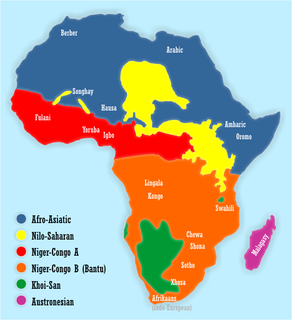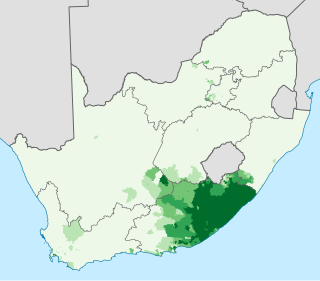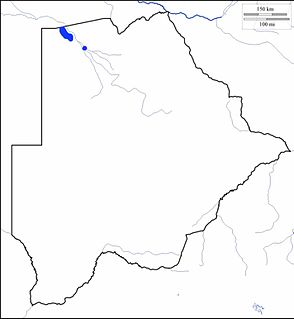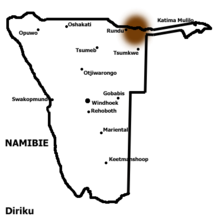
The Bantu languages are a large family of languages spoken by the Bantu peoples in the southern half of Africa. They form the largest branch of the Southern Bantoid languages.

Xhosa also isiXhosa as an endonym, is a Nguni Bantu language and one of the official languages of South Africa and Zimbabwe. Xhosa is spoken as a first language by approximately 8.2 million people and by another 11 million as a second language in South Africa, mostly in Eastern Cape, Western Cape, Gauteng and Northern Cape. It has perhaps the heaviest functional load of click consonants in a Bantu language, with one count finding that 10% of basic vocabulary items contained a click.
Lunda, also known as Chilunda, is a Bantu language spoken in Zambia, Angola and, to a lesser extent, in the Democratic Republic of the Congo (DRC). Lunda and its dialects are spoken and understood by perhaps 4.6% of Zambians, and the language is used mainly in the Northwestern province of Zambia. The majority of the Lunda can be found in DRC, especially Katanga Province, as well as in Angola. A small number of Lunda dialects are represented in Namibia.

Khwe is a dialect continuum of the Khoe family of Namibia, Angola, Botswana, South Africa, and parts of Zambia, with some 8,000 speakers.

Herero is a Bantu language spoken by the Herero and Mbanderu peoples in Namibia and Botswana, as well as by small communities of people in southwestern Angola. There were 211,700 speakers in 2014.
ǃKung (ǃXun), also known as Ju, is a dialect continuum spoken in Namibia, Botswana, and Angola by the ǃKung people, constituting two or three languages. Together with the ǂʼAmkoe language, ǃKung forms the Kxʼa language family. ǃKung constituted one of the branches of the putative Khoisan language family, and was called Northern Khoisan in that scenario, but the unity of Khoisan has never been demonstrated and is now regarded as spurious. Nonetheless, the anthropological term "Khoisan" has been retained as an umbrella term for click languages in general.
Gweno is a Bantu language spoken in the North Pare Mountains in the Kilimanjaro Region of Tanzania. The people known as the Gweno are a Chaga ethnic and linguistic group. Since the Chaga people are Bantu speakers, the adopted language contains dialects similar to that of the Kenyan language Kamba. Gweno shares about 54% to 56% of its vocabulary with other Chaga dialects and 46% with Taita dialects. However, a large percentage of its vocabulary is not seen in the other dialects. Also at the start of the 11th century, the Chaga people descended and migrated from the Bantu group in which they migrated to the foothills of mount Kilimanjaro. The Gweno language is today spoken mostly by older adults, with younger generations having shifted to Asu and Swahili. Ethnologue considers Gweno to be moribund; the language is not being passed down because children have not been exposed to Gweno since the 1970s. The generational shift from Gweno to either Asu or Swahili has certainly created shifts in dialect, however Gweno speakers do not see this as a threat.

The Ovambo language, Oshiwambo, is a dialect cluster spoken by the Ovambo people in southern Angola and northern Namibia, of which the written standards are Kwanyama and Ndonga.
Bangala is a Bantu language spoken in the northeast corner of the Democratic Republic of the Congo, South Sudan and the extreme western part of Uganda. A divergent form of Lingala, it is used as a lingua franca by people with different languages and rarely as a first language. The estimated number of speakers varies between 2 and 3.5 million. It is spoken to the east and northeast of the area where Lingala is spoken. In Lingala, Bangala translates to "People of Mongala" this means people living along the Mongala River
Yeyi is a Bantu language spoken by many of the approximately 50,000 Yeyi people along the Okavango River in Namibia and Botswana. Yeyi, influenced by Juu languages, is one of several Bantu languages along the Okavango with clicks. Indeed, it has the largest known inventory of clicks of any Bantu language, with dental, alveolar, palatal, and lateral articulations. Though most of its older speakers prefer Yeyi in normal conversation, it is being gradually phased out in Botswana by a popular move towards Tswana, with Yeyi only being learned by children in a few villages. Yeyi speakers in the Caprivi Strip of north-eastern Namibia, however, retain Yeyi in villages, but may also speak the regional lingua franca, Lozi.
Mbukushu or Thimbukushu is a Bantu language spoken by 45,000 people along the Okavango River in Namibia, where it is a national language and in Botswana, Angola and Zambia.
Kwangali, or RuKwangali, is a Bantu language spoken by 85,000 people along the Kavango River in Namibia, where it is a national language, and in Angola. It is one of several Bantu languages of the Kavango which have click consonants; these are the dental clicks c and gc, along with prenasalization and aspiration.
Namibia, despite its scant population, is home to a wide diversity of languages, from multiple language families: Germanic, Bantu, and the various Khoisan families. When Namibia was administered by South Africa, Afrikaans, German, and English enjoyed an equal status as official languages. Upon Namibian independence in 1990, English was enshrined as the nation's sole official language in the constitution of Namibia. German and Afrikaans were stigmatised as having colonial overtones, while the rising of Mandela's Youth League and the 1951 Defiance Campaign spread English among the masses as the language of the campaign against apartheid.
Maʼa is a Bantu language of Tanzania.
Fwe, or Chifwe, is a Bantu language spoken by 10,000 people along the Okavango River in the Zambezi region of Namibia and in the Western Province in Zambia. It is closely related to Kuhane, and is one of several Bantu languages of the Okavango which have click consonants.

Kuhane, or Subiya, is a Bantu language spoken by 35,000 people along the Zambezi River in Namibia, Zambia and Botswana. In Tswana it is known as Subiya. It is one of several Bantu languages of the Zambezi which have click consonants.
Zaramo is a Niger-Congo language, formerly primary language of the Zaramo people of eastern Tanzania. Zaramo is also known as Zalamo, Kizaramo, Dzalamo, Zaramu, Saramo and, Myagatwa. The language is critically endangered. The ethnic population of the Zaramo people reaches about 200,000, yet there are only a few elderly speakers remaining.
The Kavango – Southwest Bantu languages are a group of Bantu languages established by Anita Pfouts (2003). The Southwest Bantu languages constitute most of Guthrie's Zone R. The languages, or clusters, along with their Guthrie identifications, are:
Zemba (Dhimba) is a Bantu language spoken mainly in Angola where the language has about 18,000 speakers, and also in Namibia with some 4,000. It is closely related to Herero, and is often considered a dialect of that language, especially as the Zemba are ethnically Herero.
Ekoka ǃKung or Western ǃXuun is a variety of the ǃKung dialect cluster, spoken originally in the area of the central Namibian–Angolan border, west of the Okavango River, but since the Angolan Civil War also in South Africa.






